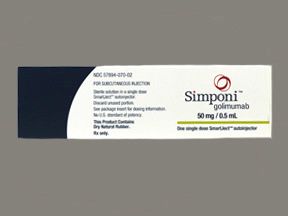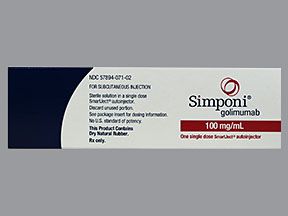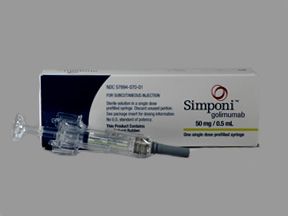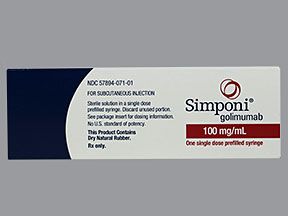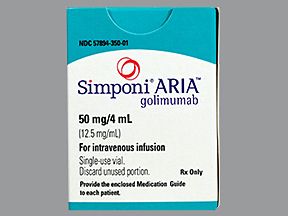Simponi and Simponi Aria (golimumab) are brand-name prescription medications. The Food and Drug Administration (FDA) has approved these drugs to treat certain autoimmune diseases:
- Simponi and Simponi Aria are approved to treat the following conditions in adults:
- moderate to severe rheumatoid arthritis when taken with methotrexate
- Simponi is also approved to treat:
- PsA when taken with or without methotrexate
- moderate to severe ulcerative colitis in adults under certain conditions
- Simponi Aria is also approved to treat the following conditions in children ages 2 years and older:
- PsA
Simponi and Simponi Aria belong to the tumor necrosis factor blocker drug class. They’re biologic medications that are available as brand-name drugs. Currently, there are no
Simponi and Simponi Aria both come as solutions. You’ll inject Simponi subcutaneously using either a single-dose prefilled syringe or a SmartJect autoinjector. Simponi Aria is given as an IV infusion by a healthcare professional. To receive Simponi Aria you’ll go to your doctor’s office, the hospital, or an infusion center.
For information about the dosage of Simponi and Simponi Aria, including their strengths and how to take them, keep reading. For a comprehensive look at Simponi and Simponi Aria and their uses, see this article.
This article describes typical dosages for Simponi and Simponi Aria provided by the drugs’ manufacturer. When taking Simponi or Simponi Aria, always follow the dosage prescribed by your doctor.
This section discusses the typical dosage of Simponi and Simponi Aria.
Simponi and Simponi Aria forms
Simponi and Simponi Aria both come as solutions:
- Simponi comes in a single-dose prefilled syringe and a SmartJect autoinjector. You’ll use either form to inject Simponi subcutaneously.
- Simponi Aria comes in a single-dose vial that’s given as an IV infusion by a healthcare professional. To receive Simponi Aria you’ll go to your doctor’s office, the hospital, or an infusion center.
Simponi and Simponi Aria strengths
Simponi comes in two strengths:
- 50 milligrams per 0.5 milliliters of solution (mg/mL)
- 100 mg/1 mL
Simponi Aria comes in one strength: 50 mg/4 mL
Typical dosages
The following information describes dosing schedules that are commonly used or recommended. However, be sure to take the dosage your doctor prescribes for you. Your doctor will determine the best dosage to fit your needs.
For details about the children’s dosage for psoriatic arthritis (PsA) or polyarticular juvenile idiopathic arthritis (pJIA), see the “Children’s dosage” section below.
Dosage for rheumatoid arthritis (RA) in adults
The table below describes the typical dosing schedules of Simponi and Simponi Aria for RA in adults.
Note: If you’re prescribed Simponi Aria, you’ll have a more frequent dosing schedule when you start treatment. However, after the first two doses of Simponi Aria, you’ll receive the drug once every 8 weeks. This is described below.
| Drug | Dose for RA | Dose frequency |
| Simponi | 50 milligrams (mg) | once per month |
| Simponi Aria | 2 mg per kilogram (kg) | • week 0 (first dose) • week 4 (second dose) • once every 8 weeks after your first two doses |
If you’re prescribed Simponi Aria, your doctor will calculate your total dose based on your weight in kg. One kg is about 2.2 pounds (lb). For example, if you weigh 65 kg (about 143 lb), your total dose would be 130 mg.
Dosage for ulcerative colitis (UC) in adults
To treat UC, your doctor will likely give you a loading dose (starting dose) of Simponi. This is a 200-mg dose that’ll be injected subcutaneously. Your doctor will teach you how to give yourself the other doses.
Two weeks after your first dose, you’ll give yourself a 100-mg dose. Four weeks later, you’ll inject another 100-mg dose. This will be your maintenance (long-term) dose that you’ll inject every 4 weeks.
Note: The Food and Drug Administration (FDA) hasn’t approved Simponi Aria to treat UC.
Dosages for psoriatic arthritis (PsA) in adults
The table below describes the typical dosing schedules of Simponi and Simponi Aria for PsA in adults.
| Drug | Dose for PsA | Dose frequency |
| Simponi | 50 milligrams (mg) | once per month |
| Simponi Aria | 2 mg per kilogram (kg) | • week 0 (first dose) • week 4 (second dose) • once every 8 weeks after your first two doses |
If you’re prescribed Simponi Aria, your doctor will calculate your total dose based on your weight in kg. One kg is about 2.2 lb. For example, if you weigh 65 kg (about 143 lb), your total dose would be 130 mg.
Simponi Aria is approved to treat PsA in certain children. For details about children’s dosage, see the “Children’s dosage” section below.
Dosages for ankylosing spondylitis in adults
The table below describes the typical dosing schedules of Simponi and Simponi Aria for ankylosing spondylitis in adults.
| Drug | Dose for ankylosing spondylitis | Dose frequency |
| Simponi | 50 milligrams (mg) | once per month |
| Simponi Aria | 2 mg per kilogram (kg) | • week 0 (first dose) • week 4 (second dose) • once every 8 weeks after your first two doses |
If you’re prescribed Simponi Aria, your doctor will calculate your total dose based on your weight in kg. One kg is about 2.2 lb. For example, if you weigh 65 kg (about 143 lb), your total dose would be 130 mg.
Children’s dosage
Simponi Aria is FDA-approved to treat psoriatic arthritis (PsA) and polyarticular juvenile idiopathic arthritis (pJIA) in children ages 2 years and older. The dosing schedule of Simponi Aria for children is the same for both conditions.
Dosage for PsA in children
The table below describes the typical dosing schedule of Simponi Aria for PsA in children.
| Drug | Dose for PsA in children | Dose frequency |
| Simponi Aria | 80 milligrams per meters squared (mg/m2) | • week 0 (first dose) • week 4 (second dose) • once every 8 weeks after your first two doses |
The total dose of Simponi Aria for PsA in children is based on the child’s body surface area (height and weight). Your doctor will calculate the right dosage to treat PsA in your child.
Note: The Food and Drug Administration (FDA) hasn’t approved Simponi to treat PsA in children.
Dosage for pJIA in children
The table below describes the typical dosing schedule of Simponi Aria for pJIA in children.
| Drug | Dose for pJIA in children | Dose frequency |
| Simponi Aria | 80 milligrams per meters squared (mg/m2) | • week 0 (first dose) • week 4 (second dose) • once every 8 weeks after your first two doses |
The total dose of Simponi Aria for pJIA in children is based on the child’s body surface area (height and weight). Your doctor will calculate the right dosage to treat pJIA in your child.
Note: The FDA hasn’t approved Simponi to treat pJIA in children.
Long-term use
Simponi and Simponi Aria are meant to be taken as long-term treatments. If you and your doctor determine that Simponi or Simponi Aria is safe and effective for you, you’ll likely take it long term.
The Simponi or Simponi Aria dosage your doctor prescribes will depend on several factors. These include:
- whether you’re prescribed Simponi or Simponi Aria
- the type and severity of the condition your doctor prescribes Simponi or Simponi Aria to treat
- your age
- your weight
- your height
- other medical conditions you have
Find information below on how Simponi and Simponi Aria are given.
How to use Simponi
Simponi comes as a solution in a single-dose prefilled syringe or a SmartJect autoinjector. Both forms are injected subcutaneously. If you have questions about whether the prefilled syringe or SmartJect autoinjector is best for you, talk with your doctor.
Your doctor will likely give you your first dose of Simponi and teach you how to inject it into yourself correctly. Then you or your caregiver will inject the drug according to your dosage schedule.
With either form of Simponi, you’ll inject your dose into one of the following sites:
- lower abdomen, at least 2 inches from your belly button
- front of your thigh
- back of your upper arm
Be sure to rotate your injection site with each dose. And do not inject into any areas that are tender, bruised, red, scaly, or hard.
To learn more about how to inject your Simponi dose, refer to the manufacturer’s website for instruction videos. You can also see Simponi’s instructions for use. Or you can talk with your doctor or pharmacist about how best to inject Simponi.
How you’ll receive Simponi Aria
Simponi Aria comes as a solution that’s given as an IV infusion by a healthcare professional. To receive Simponi Aria you’ll go to your doctor’s office, the hospital, or an infusion center. Each infusion usually takes about 30 minutes.
For more information about your Simponi Aria infusion, talk with your doctor.
If you miss a dose of Simponi, inject the missed dose as soon as you remember. You can then continue your normal dosing schedule.
If you miss an appointment to receive your dose of Simponi Aria, call your doctor to reschedule.
If you’re unsure whether to take a missed dose of Simponi or Simponi Aria, talk with your doctor or pharmacist.
To help make sure you don’t miss a dose, try using a medication reminder. This can include setting an alarm or using a timer. You could also download a reminder app on your phone.
If you’re prescribed Simponi, it’s important that you do not inject more than your doctor prescribes. For some medications, taking more than the recommended amount may lead to side effects or overdose.
If you’re prescribed Simponi Aria, your dose will be calculated and given to you by a healthcare professional.
If you inject or receive more than the recommended amount of Simponi or Simponi Aria
Call your doctor right away if you believe you’ve injected too much Simponi or received too much Simponi Aria. Another option is to call the American Association of Poison Control Centers at 800-222-1222 or use their online tool. If you have severe symptoms, immediately call 911 or your local emergency number, or go to the nearest emergency room.
The dosages in this article are typical dosages provided by the drugs’ manufacturer. If your doctor recommends Simponi or Simponi Aria for you, they will prescribe the dosage that’s right for you. Always follow the dosage that your doctor prescribes for you.
As with any drug, never change your dosage of Simponi or Simponi Aria without your doctor’s recommendation. If you have questions about the dosage that’s right for you, talk with your doctor.
Besides learning about dosage, you may want more information about Simponi and Simponi Aria. These additional articles might be helpful:
- More about Simponi and Simponi Aria. For information about other aspects of Simponi and Simponi Aria, refer to this article.
- Details about your condition.
- If you use Simponi or Simponi Aria to treat rheumatoid arthritis (RA) or another a form of arthritis, see our RA hub or arthritis hub. You can also see these lists of rheumatology and psoriatic arthritis articles.
- For information about ulcerative colitis, see this list of related articles.
Disclaimer: Medical News Today has made every effort to make certain that all information is factually correct, comprehensive, and up to date. However, this article should not be used as a substitute for the knowledge and expertise of a licensed healthcare professional. You should always consult your doctor or another healthcare professional before taking any medication. The drug information contained herein is subject to change and is not intended to cover all possible uses, directions, precautions, warnings, drug interactions, allergic reactions, or adverse effects. The absence of warnings or other information for a given drug does not indicate that the drug or drug combination is safe, effective, or appropriate for all patients or all specific uses.

